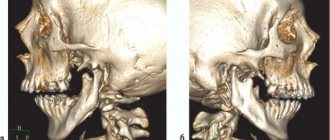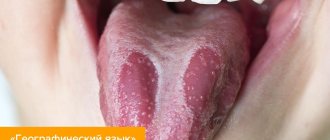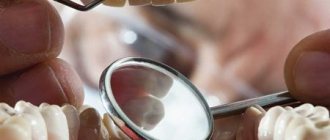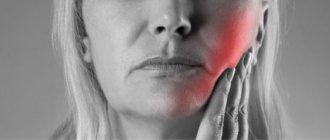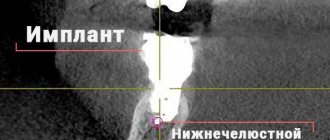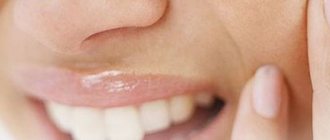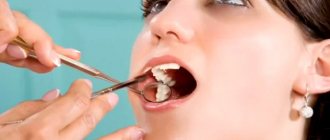Reasons for the development of micrognathia
Anomalies of jaw development can be congenital or acquired.
Congenital ones include:
- Severe acute illnesses of a woman during pregnancy,
- Anomalies of intrauterine development of the fetus,
- Congenital pathologies of the development of the dental system,
- Genetic predisposition.
An acquired anomaly can result from:
- Maxillofacial trauma,
- Artificial feeding and improper sucking in infancy,
- Diseases of the endocrine system,
- Past infectious diseases and inflammatory processes,
- Early loss of baby teeth,
- Problems with nasal breathing.
Reliable fixation using mini-implantation
For cases where full-fledged classical implantation cannot be carried out, and the patient is completely unprepared to use removable dentures, it is possible to use a conditionally fixed technique. It involves, on the one hand, reliable fixation of the prosthesis, and at the same time the patient has the opportunity to remove and put it on independently. Of course, such fixation does not allow you to restore chewing function in the same way as with conventional implantation, but it allows you to calmly chew food and communicate without fear of the prosthesis falling out of your mouth.
Mini-implants are very thin implants; they are a one-piece structure; the prosthesis is immediately fixed on them, without the use of additional superstructures. The lower part of the mini-implant - its main body - is similar to a thin screw; it is installed into the jaw bone transgingivally - without cutting the gums, and the outer, smaller part, shaped like a ball, serves as a stopper for the prosthesis. Mini-implants are used to fix a removable denture on the jaw; in this case, the denture is also called an overdenture. A small bone volume is not an absolute contraindication; after installing mini-implants, a prosthesis can be installed immediately. Such implants are not used as a support for crowns, only for fixing a removable denture, acting as a retainer.
The spherical heads of mini-implants are snapped into special locks installed inside the prosthesis.
The mini-implant is made of titanium and is similar to a screw, but much smaller. There are significantly fewer contraindications for their installation than for classic root-shaped implants, only extreme cases of systemic diseases.
This type of implant is installed through surgery; it is possible to use implant templates. It is very important to maintain strict hygiene during this period of time and follow all doctor’s instructions.
Diagnosis and treatment of narrow jaw
Deformed dentition, crowded teeth, malocclusion, unerupted teeth are consequences of an underdeveloped dental system. The earlier these abnormalities are diagnosed, the more effective the treatment will be. To expand the lower and upper jaws, therapeutic methods, mechanical expanders and plates are used. In rare cases, only surgery helps.
In children under 10-11 years old, jaw expansion gives the best results. This is a time of active growth and formation of bone tissue, so the defect can be corrected with the help of orthodontic structures.
Plate complete removable denture
A complete removable denture of the lower jaw is a base - a specially curved plate of plastic (acrylic or nylon) covering the jaw, on which artificial teeth are fixed, usually made of plastic or ceramic (more expensive). Usually, the lower prosthesis is smaller than the upper one, because it is fixed to the lower alveolar ridge, the upper one is fixed entirely to the palate.
The lower jaw prosthesis is held on the gum due to the anatomical protrusion of the jaws and the peculiar suction ability of the gums, which allows the prosthesis to be held without using any additional means for attachment.
Complete removable dentures are used under the following circumstances:
- Complete absence of teeth in a person and the inability to attach other types of removable or fixed dentures;
- Contraindications to bone grafting and dental implantation;
- Allergic reaction to metals or their individual intolerance;
- As a temporary solution for the period of implant healing or after tooth extraction.
Modern methods of treating complete secondary edentia of the lower jaw make it possible to restore the functionality of the dental system by 80-90%. In some cases, the aesthetics can also be perfect. We are talking about dental implants.
Expansion of the lower jaw
A narrow lower jaw, or microgenia, can be corrected in childhood with special devices - distractors. This is a device that gradually stretches the bones of the lower jaw. New bone and soft tissue grows at the site of the sprain. When installing a distractor, first increase the distance between the canines of the lower jaw. Every day the device allows you to increase the lower jaw by 1 mm. When the jaw is wide enough to accommodate tooth growth, the distractor is placed in place for at least two weeks to stabilize the sprain.
If you have a problem similar to that described in this article, be sure to contact our specialists. Don't diagnose yourself!
Why you should call us now:
- We will answer all your questions in 3 minutes
- Free consultation
- The average work experience of doctors is 12 years
- Convenient location of clinics
Single contact phone number: +7
Make an appointment
In adult patients, the lower jaw bones are fused and cannot be stretched, as in children. Therefore, to enlarge the lower jaw, the surgeon cuts the bone in several places with an ultrasonic knife. On the fourth day after surgery, an expansion device is installed. The first adjustment of the stretching is carried out by an orthodontist, then the patient himself controls the stretching process, which can take up to six months.
After expanding the lower jaw, braces are installed on the lower front teeth to correct the bite. Crowded teeth gradually occupy the resulting space.
The photo below shows a narrow jaw before and after expansion.
Prosthesis on implants
The main advantages of implantation are the ability to firmly fix the prosthesis in the oral cavity, so a person does not worry that the prosthesis may fall out at an unexpected moment, creating an awkward situation, the ability to chew food without problems and not refuse hard and sticky foods, which has a positive effect on the gastrointestinal tract. -intestinal tract and on the patient’s mood.
One of the main questions that interests most patients planning to install dentures on implants is how many implants need to be installed. After all, this affects, among other things. and the cost of treatment. For each case, this amount is different and is determined after studying the general clinical situation individually. The determining factor is the condition of the bone tissue and the amount of costs that the patient expects.
As basic figures, you can focus on the following: 8 pieces are needed if one large bridge prosthesis is installed on implants and 12-14 for combined prosthetics with single crowns and small bridges. As an example, the work with the installation of a complete ceramic fixed prosthesis on the upper jaw on 8 implants is given.
Primary and secondary edentulous teeth
Experts distinguish several types and subtypes of adentia. For greater convenience, below are tables showing the types of the disease, combined by certain characteristics.
Primary adentia
Caused by hereditary factors and diseases at the stage of fetal formation. With primary adentia, there is an absence of tooth germs.
Varies:
- partial primary adentia - the absence of one or more rudiments (for example, primary adentia of two incisors);
- complete primary adentia – absence of all tooth buds. It is extremely rare;
- true adentia – absence of tooth buds (without their destruction by diseases and infections);
- false edentia, when different teeth merge into one.
Secondary adentia
Secondary adentia (ICB K 08.1) occurs as a result of illnesses and injuries during life.
Causes of edentia
The first cause of adentia is periodontitis.
The second cause of edentia is caries.
The third reason for tooth loss is pulpitis
The fourth cause of adentia is periodontitis.
The fifth possible cause of adentia is hypoplasia
The most common thing is the lack of proper oral hygiene and care.
There are three diseases that provoke tooth loss - periodontitis (soft tissue diseases), caries and its complications (pulpitis and periodontitis) and hypoplasia (underdevelopment of tooth tissue, most often enamel).
There are other reasons for tooth loss - due to a blow or some complex disease - but such cases are exceptions to general practice, so we will not dwell on them in detail.
The main reason leading to tooth loss is, after all, a lack of proper attention to one’s health and letting the first signs of illness take their course.
There is no consensus or single way to prevent caries or periodontitis; the occurrence of these diseases can be influenced by various factors - genetic predisposition, poor nutrition, poor hygiene and even the area of residence. But timely diagnosis and proper treatment always save the patient from many further health problems.
Classification of missing teeth according to the location of the disease
| By localization | Description |
| Missing upper teeth | The absence of teeth in the upper jaw can be either partial or complete, as well as single. |
| Missing lower teeth | A general designation for a disease indicating the absence of teeth in the lower jaw. |
| Lack of chewing teeth | May be referred to as missing lateral teeth. Lack or complete edentulism in the chewing region. In particular, we are talking about the absence of small molars (premolars) and molars. |
| Missing front teeth | Edentia of incisors or canines in the frontal zone. |
In addition to the classification described above, the type of teeth itself is also taken into account. Based on this, the absence of molars and edentulous primary teeth (not associated with the normal timing of their replacement) are distinguished.
